Helping others spurs ‘Philanthropist of the Year’
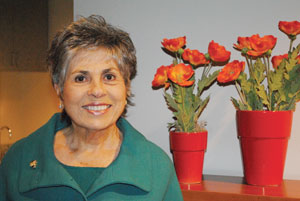 Mary Davidson Cohen lives by the philosophy that as Jews, we should do whatever we can to repair our world as best we can.
Mary Davidson Cohen lives by the philosophy that as Jews, we should do whatever we can to repair our world as best we can.
“If I can help a little bit, I feel like it is my responsibility as a person who has been very fortunate in life to do that,” Cohen said in a recent interview.
On May 11 Cohen will be honored as 2012 Philanthropist of the Year at the 28th Annual Philanthropy Awards Luncheon presented by Nonprofit Connect. This is the first time since Norman and Elaine Polsky were honored in 2002 that a Jewish philanthropist is receiving this honor.
Cohen serves as executive director of the Barton P. and Mary D. Cohen Charitable Trust. She is very honored and humbled to be recognized as Philanthropist of the Year.
“The truth is there are three of us that are being honored: my father-in-law Joseph Cohen, my husband Barton P. Cohen and me. I’m the steward of the money. It’s a wonderful, wonderful position to be in and a real responsibility to see to it that the money goes where they would want it to go and where I know it should go and where the community needs it”
“There are a lot of people out there that do wonderful things and it’s an honor that they chose the Cohen Charitable Trust and me to honor,” she continued.
The Cohen trust was formed in 2007 following the sale of Metcalf Bank. As executive director, Cohen makes all the grant decisions within the parameters of Bart Cohen’s will. Financial professionals invest the money and take care of all accounting responsibilities.
Cohen brings to philanthropy the wisdom of her lifelong career in education, which she began as a teacher in the Kansas City (Mo.) Public Schools. Through the years, she has produced and appeared in films to teach science, served as vice chancellor for academic affairs at the University of Kansas Regents Center, assistant director of the William T. Kemper Foundation, vice president for adult and continuing education and dean of the graduate school at Saint Mary University in Leavenworth and, from 2002 to 2007 as the regional representative for the Secretary of the U.S. Dept. of Education.
The Cohen Trust makes grants in support of the arts, education, history, libraries, social justice and religious organizations for programs that continue the Cohens’ commitment to bettering the communities to which they belonged.
As an educator, it’s not surprising that first grant Cohen made was to the Children’s Campus of Kansas City, located in Kansas City, Kan. Incorporated in 2004, the mission of CCKC is to assure that children birth to 5 years of age who are most at risk for academic failure access the resources they need to succeed in school and life.
Cohen explains CCKC as a preschool owned and operated by the University of Kansas serving the economically depressed population of Wyandotte County.
“The kids are so cute,” she said. “They take 132. The bad news is there are 5,000 children in that area who are eligible for services. The good part is you can give children a better chance in life 132 at a time.”
Cohen is most proud of a grant she made to the University of Missouri-Kansas City School of Law which honors her father, Julian K. Davidson.
“It’s the one grant that Bart and I talked about for a number of years if he ever sold the bank and established the charitable trust,” she explained.
Julian K. Davidson graduated in 1905 from the old Kansas City School of Law. In those days a law degree was an undergraduate degree, but he continued his studies at the University of Michigan. The 10-year-grant covers the tuition and other miscellaneous costs of three law students known as Davidson scholars. Two are enrolled now and the third will enroll in the fall of 2012.
“I think that Jews feel that we are best remembered by what we’ve done on earth and the good that we leave behind us. I know that my father would be absolutely so pleased with that scholarship that allows young people to attend school that otherwise might not have that opportunity. He would be most pleased because his name will always be at the law school,” Cohen said.
The Philanthropist of the Year honor is being presented to Cohen in recognition of grants given primarily to organizations in the general community. A different fund, established following Bart Cohen’s death in 2006, provided several substantial grants to organizations in the Jewish community under the name of the Margaret and Joseph Cohen Trust.
“The income from that does wonderful things in the Jewish community,” Cohen said. “I think it is most important for us as Jews to understand that if we don’t help our own, nobody is going to.”
“It always makes me feel good to know that Bart’s parents are memorialized and I know that good things are done that help all of us. If one of us is helped, all of us are helped. That to me is really the bottom line,” Cohen said.
While the Cohen trust gives primarily to secular causes, Cohen said she has presented a few supplemental grants to Jewish communal organizations.
“For example, Jewish Family Services does wonderful things, particularly for the elderly,” Cohen said. “Jewish causes are always good social causes and most of them offer direct services to our Jewish community whether it is here or throughout the world. Therefore we have an obligation to see to it that our fellow Jews are taken care of as well as we can possibly see to it. Those grants are very important as well.”
Cohen has also given money to The Temple, Congregation B’nai Jehudah, to be used in the restoration of the Jewish section of Elmwood Cemetery.
“The history of the old Jewish community is in Section H, the Jewish section,” she said. “I want to be sure that Section H is kept up. Hopefully what we do in the Jewish section will encourage other people to adopt sections of the cemetery and make it something lovely and help the whole neighborhood. The history of Kansas City is in Elmwood Cemetery.”
Cohen also volunteers on various boards throughout the community. She is chairman of the board of the World War I Museum.
“I think that the World War I Museum is an amenity not only to this community but to the whole world. The collection there is without equal,” she said. Cohen believes it is important to the Kansas City community to pull all amenities together to make more of an economic attraction for tourists.
“I think the economic impact of all these amenities like, the World War I Museum and the new aquarium at Crown Center and the Nelson gallery and the Kemper Museum, … are terrific. If we can do something to encourage people to come and visit them, then we should do it. I feel we all have a responsibility to our community, in whatever pieces that may touch our lives.”



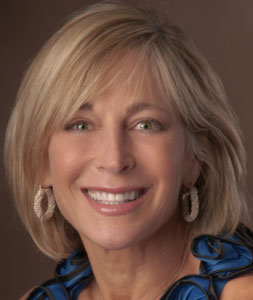 What would you do if doctors told you at the age of 9 you would be lucky to celebrate your 18th birthday? First it made Shelly Weiner Maguire angry and defiant. Then it motivated her to push herself to the limit and stop at nothing to reach her goals to be a successful businesswoman and live a long life. Now 51, Maguire has recently written about her struggles and successes in “Dancing in the Storm.”
What would you do if doctors told you at the age of 9 you would be lucky to celebrate your 18th birthday? First it made Shelly Weiner Maguire angry and defiant. Then it motivated her to push herself to the limit and stop at nothing to reach her goals to be a successful businesswoman and live a long life. Now 51, Maguire has recently written about her struggles and successes in “Dancing in the Storm.”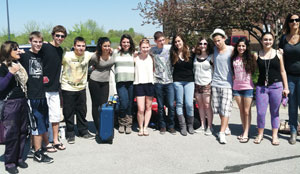 Last year, when the Hyman Brand Hebrew Academy freshmen went on their trip to Israel, they stayed with host families from Kansas City’s sister region of Gezer, in central Israel. On Wednesday, March 28, the Israeli teens that housed the HBHA students last year flew to Kansas to stay with their HBHA friends until Saturday morning, March 31.
Last year, when the Hyman Brand Hebrew Academy freshmen went on their trip to Israel, they stayed with host families from Kansas City’s sister region of Gezer, in central Israel. On Wednesday, March 28, the Israeli teens that housed the HBHA students last year flew to Kansas to stay with their HBHA friends until Saturday morning, March 31.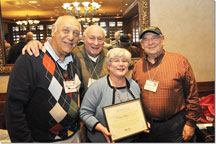
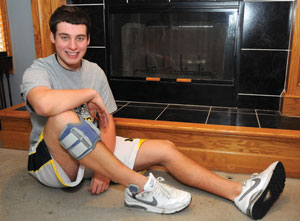 As Jews, we think of miracles at Chanukah when the oil lasted for eight days instead of one. We also think of miracles when the Red Sea parted, allowing our ancestors to continue fleeing Egypt even after the Egyptian army began pursuit.
As Jews, we think of miracles at Chanukah when the oil lasted for eight days instead of one. We also think of miracles when the Red Sea parted, allowing our ancestors to continue fleeing Egypt even after the Egyptian army began pursuit. Noah had been diagnosed and was able to leave the hospital, but he wasn’t well.
Noah had been diagnosed and was able to leave the hospital, but he wasn’t well.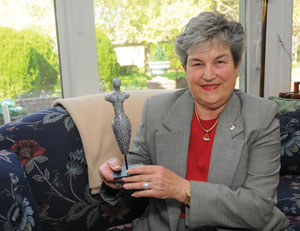 A life devoted to women’s rights is one way to define Barbara Holzmark, this year’s recipient of the Dr. George Tiller Courage Award. The Kansas Choice Alliance presented Holzmark with the award on March 14 in Topeka during its annual Voices for Choice event. She has been fighting the battle for a woman’s right to control her own health for more than 25 years. It is a battle that is still at the forefront of politics today.
A life devoted to women’s rights is one way to define Barbara Holzmark, this year’s recipient of the Dr. George Tiller Courage Award. The Kansas Choice Alliance presented Holzmark with the award on March 14 in Topeka during its annual Voices for Choice event. She has been fighting the battle for a woman’s right to control her own health for more than 25 years. It is a battle that is still at the forefront of politics today. Rita Blitt’s short film, “Collaborating with the Past,” has been selected for showing at the Kansas City FilmFest. Blitt’s short will be shown prior to “Andrew Bird: Fever Year” at 5 p.m. Wednesday, April 11, at AMC Mainstreet 6 located at 1400 Main Street in downtown Kansas City. It will be shown again at 8:15 p.m. Saturday, April 14, at the Ward Parkway 14 located at 8600 Ward Parkway, also preceding “Andrew Bird: Fever Year.”
Rita Blitt’s short film, “Collaborating with the Past,” has been selected for showing at the Kansas City FilmFest. Blitt’s short will be shown prior to “Andrew Bird: Fever Year” at 5 p.m. Wednesday, April 11, at AMC Mainstreet 6 located at 1400 Main Street in downtown Kansas City. It will be shown again at 8:15 p.m. Saturday, April 14, at the Ward Parkway 14 located at 8600 Ward Parkway, also preceding “Andrew Bird: Fever Year.” Six Jewish Korean War veterans — Mel Cosner, Marvin Denton, Jack Hirsekorn, Bob Hoffman, Abe Levine and Stan Silverman — recently met at the Jewish Community Campus to recreate a photo taken in April 1952, 60 years ago, in Seoul, South Korea.
Six Jewish Korean War veterans — Mel Cosner, Marvin Denton, Jack Hirsekorn, Bob Hoffman, Abe Levine and Stan Silverman — recently met at the Jewish Community Campus to recreate a photo taken in April 1952, 60 years ago, in Seoul, South Korea.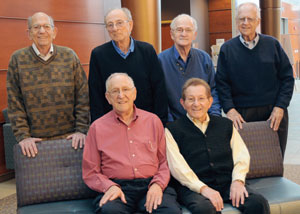 The six vets believe a total of 800 Jewish soldiers were driven to Seoul for the service that day. Only a service was held, they were not served a Passover meal.
The six vets believe a total of 800 Jewish soldiers were driven to Seoul for the service that day. Only a service was held, they were not served a Passover meal.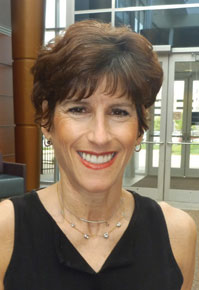 It had been years since Vicki Belzer worked outside the home; she was very busy raising her two children. With her son and daughter grown, and Belzer now divorced, she was ready to get back out in the work force, and needed help. That’s when a friend told her about Jewish Employment Services and Career Coach Joyce Hill.
It had been years since Vicki Belzer worked outside the home; she was very busy raising her two children. With her son and daughter grown, and Belzer now divorced, she was ready to get back out in the work force, and needed help. That’s when a friend told her about Jewish Employment Services and Career Coach Joyce Hill.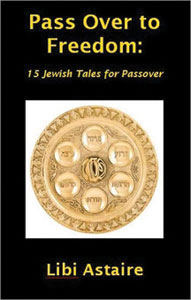 Libi Astaire, a writer who grew up in the Kansas City Jewish community and now lives in Jerusalem, has just published this, the third in her e-book series of Chassidic/Jewish stories for the holidays.
Libi Astaire, a writer who grew up in the Kansas City Jewish community and now lives in Jerusalem, has just published this, the third in her e-book series of Chassidic/Jewish stories for the holidays.